Jewelry photography is an art that requires precision and attention to detail to showcase intricate designs and sparkling gemstones. Capturing the true beauty of these pieces can be challenging, but with the right settings, stunning results are achievable.
But, what settings should I use for jewelry photography?
The best results are obtained with a low ISO of 100-200 to minimize noise, a small aperture of f/11-f/16 for depth of field, a fast shutter speed to avoid blur, and manual focus for precision. Also, set the white balance according to your light source to ensure accurate colors.
In this article, we’ll explore each setting in greater detail and share tips for perfecting your jewelry photography.
What is Jewelry Photography and its Purpose?
Jewelry photography is a specialized field that captures jewelry pieces’ elegance and intricacy. It requires a keen eye for detail and a deep understanding of lighting and composition. The purpose is to present these items in the most attractive way possible, highlighting their beauty and craftsmanship.
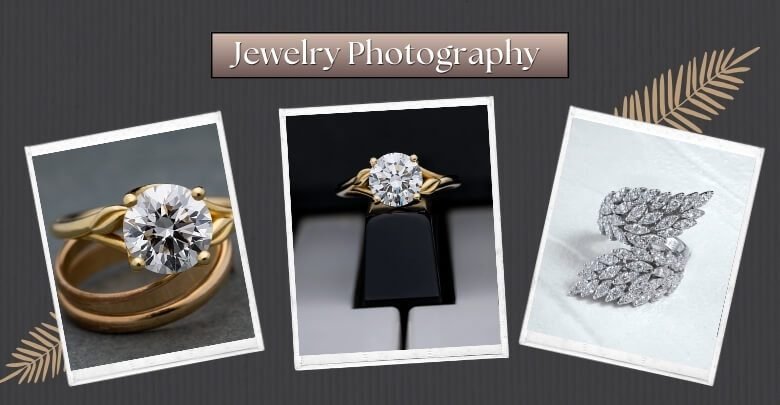
This type of photography serves several key purposes, including advertising, cataloging, and online sales. It helps jewelers and designers showcase their work to potential customers, enticing them with stunning visuals. In that case, jewelry photo editing plays a crucial role in enhancing these images, ensuring they look their best.
By presenting jewelry in its best light, photography conveys the value and quality of the pieces. It allows customers to appreciate the fine details and craftsmanship of each item. Overall, jewelry photography is an essential tool for selling and promoting exquisite creations.
Different Types of Jewelry Photography
Photographing jewelry is a delicate craft that revolves around encapsulating the allure of adornments. Within this realm, numerous styles cater to various purposes.
Taking good jewelry photos requires an understanding of lighting, composition, and meticulous attention to detail. Let’s take a look into the diverse types of jewelry photography:
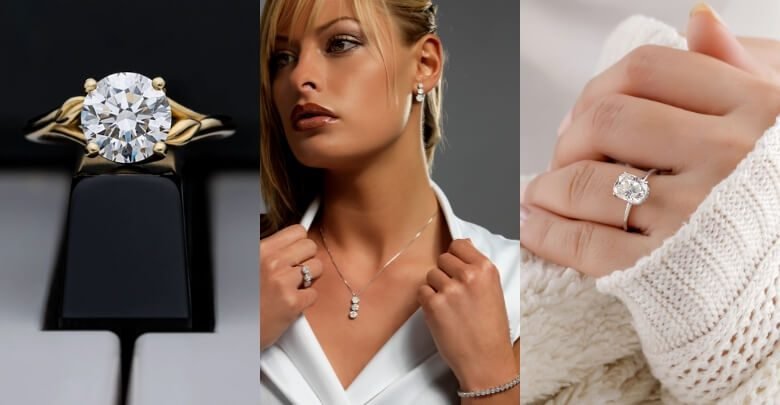
Studio Photography
Studio photography involves capturing jewelry in a controlled environment with professional lighting. This type creates crisp, clear images that showcase the item’s details. It’s ideal for product catalogs and online stores. The background is usually neutral to keep the focus on the jewelry.
Macro Photography
Macro photography is all about close-up shots of small objects. It’s suitable for highlighting intricate details of jewelry. This type requires specialized lenses and steady hands. The resulting images are often used for detailed product descriptions and quality inspections.
Lifestyle Photography
Lifestyle photography places jewelry in real-life settings or on models. It helps potential buyers visualize how jewelry looks when worn. This type is commonly used in advertisements and social media. It adds a personal touch and context to jewelry.
Creative Photography
Creative photography allows artistic expression, using creative backgrounds, lighting, and angles. It’s used to create eye-catching images that stand out. This type is often seen in high-end fashion magazines and art galleries. It emphasizes jewelry’s artistic value rather than details.
Editorial Photography
Editorial photography tells a story or conveys a theme, often featuring jewelry as part of a larger narrative. It’s used in magazines and blogs to create a mood or convey a message. This type combines fashion and jewelry, showcasing them in themed settings. It’s more about the overall look than just the jewelry.
The field of jewelry photography can be divided into many types to serve different purposes. From the precision of studio shots to the creativity of editorial spreads, each type has its unique appeal and challenges.
Crucial Elements for Carrying Out Good Jewelry Photography
Jewelry photography is an intricate art that demands precision and creativity. Capturing the true essence of these delicate pieces requires attention to detail. Here are some crucial elements for achieving good jewelry photography:
- Proper Lighting: Lighting is key in jewelry photography to reveal sparkle and details. Use a combination of natural and artificial light sources for balanced illumination.
- Stable Tripod: A tripod ensures stability, reducing blurry images. It’s essential for maintaining sharpness, especially in macro photography.
- Clean Background: A clean, uncluttered background keeps the focus on the jewelry. Opt for neutral colors like white or gray to avoid distractions.
- High-Quality Camera: Invest in a camera with good resolution and macro capabilities. It’s crucial for capturing jewelry’s fine details and textures.
- Post-Processing: Editing is vital to enhance the final image. Use photo editing software to adjust brightness, contrast, and color balance.
- Creative Composition: Experiment with different angles and compositions to showcase jewelry uniquely. It adds visual interest and highlights the item’s most impressive features.
Good jewelry photography combines technical skills with artistic vision. By paying attention to these crucial elements, you can enhance your jewelry images.
What Settings Should I Use for Jewelry Photography?
A jewelry photographer must have an eye for detail and precision when taking pictures of jewelry. The right settings on the camera are essential for capturing each piece’s beauty and sparkle. Here are some essential settings to consider for jewelry photography:
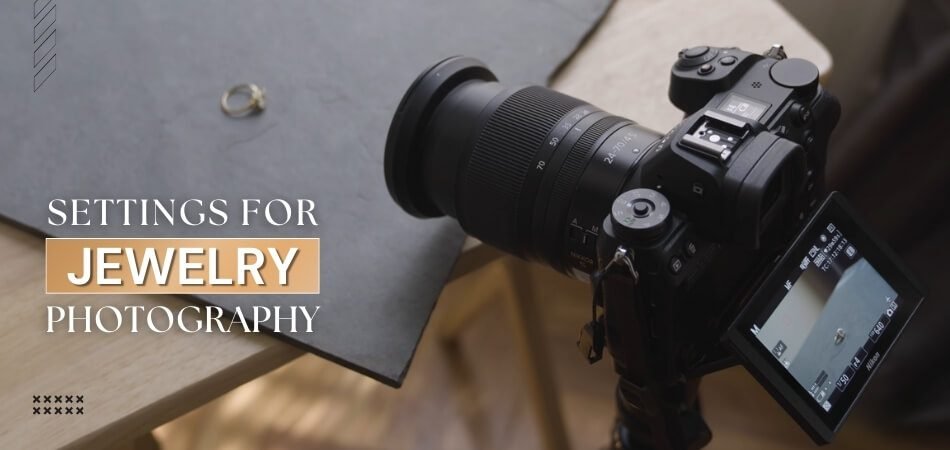
ISO Setting
Keep the ISO low, between 100-200, to minimize noise in your images. Low ISO ensures cleaner and clearer photos. It’s especially helpful for capturing the fine details of jewelry. Higher ISO can be used in low light, but be cautious of graininess.
Aperture Setting
Use a small aperture, around f/11 to f/16, to achieve greater depth of field. This keeps more of the jewelry in focus. A smaller aperture allows for sharper details across the entire piece. Be mindful of your shutter speed when adjusting the aperture.
Shutter Speed
Choose a fast shutter speed to avoid motion blur. This is critical when handholding the camera or for capturing moving parts. A speed of 1/125th or faster is typically sufficient. If using a tripod, you can opt for a slower speed.
White Balance
Set the white balance according to your light source to ensure accurate colors. This is crucial for showing gemstone and metal hues. Auto white balance can work, but manual adjustment provides better control. Experiment with different settings to find the right match for your lighting.
Focus Mode
Use manual focus for precise control of the focus area. Jewelry photography often requires focusing on specific details. Autofocus can sometimes miss the mark on small, intricate pieces. Manual focus ensures the most important parts are sharp.
Metering Mode
Spot metering is useful for jewelry photography as it measures light from a small area. This helps expose jewelry, which is often the focal point. Matrix or evaluative metering might not give accurate results due to the small jewelry size. Spot metering ensures the exposure is based on the jewelry itself, not the background.
By mastering these settings, you can significantly improve the quality of your jewelry photographs. You will need to experiment and practice to find the perfect combination for your setup and style.
Is it Important to Find the Right Camera Settings for Jewelry Photography?
Yes, finding the right camera settings is crucial for jewelry photography. This type of photography demands precision to capture intricate details and true colors. The correct settings can make the difference between an average photo and a stunning one.
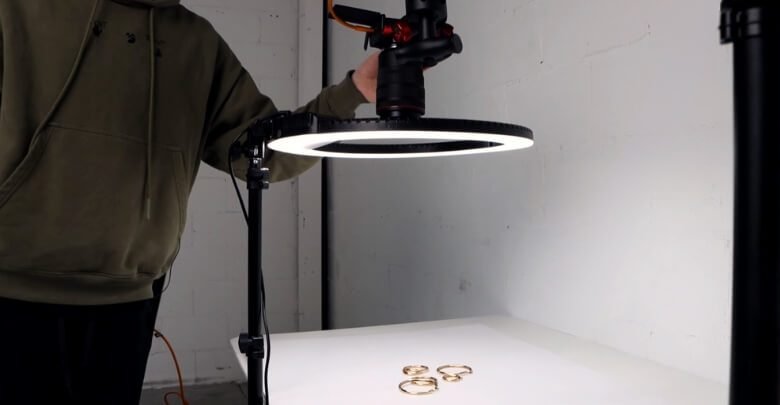
Detail Clarity
High-resolution settings are essential to capturing jewelry details. A low ISO and a small aperture ensure sharpness. These settings reduce noise and increase the depth of field. Clear details are vital for showcasing the jewelry’s craftsmanship.
Color Accuracy
Accurate color representation is crucial in jewelry photography. The white balance setting plays a significant role in this. It ensures that the colors of gemstones and metals are true. Incorrect colors can mislead customers and affect sales.
Lighting Control
Proper exposure settings are necessary to handle jewelry’s reflective nature. Overexposure can lead to lost details, while underexposure can make jewelry look dull. The right balance ensures vibrant and eye-catching jewelry. It highlights the sparkle and shine that attract buyers.
Focus Precision
The focus setting is critical for highlighting specific details of jewelry. Manual focus allows precise control over the sharpness area. Autofocus may not capture all the details you desire. Having a precise focus draws attention to the most important features.
Consistency
Consistent camera settings help maintain uniform looks across photos. This is important for cohesive product listings or catalogs. It ensures that all pieces are presented similarly. Consistency builds a professional and trustworthy brand image.
The right camera settings are crucial to successful jewelry photography. Their job is to ensure clarity, color accuracy, proper lighting, precision focus, and consistency, all of which are imperative for displaying jewelry in its best light.
When to Seek Professional Help?
Sometimes, despite our best efforts, we find ourselves needing a bit of extra help. It’s important to recognize when professional assistance is needed. Here are some situations where it might be necessary:
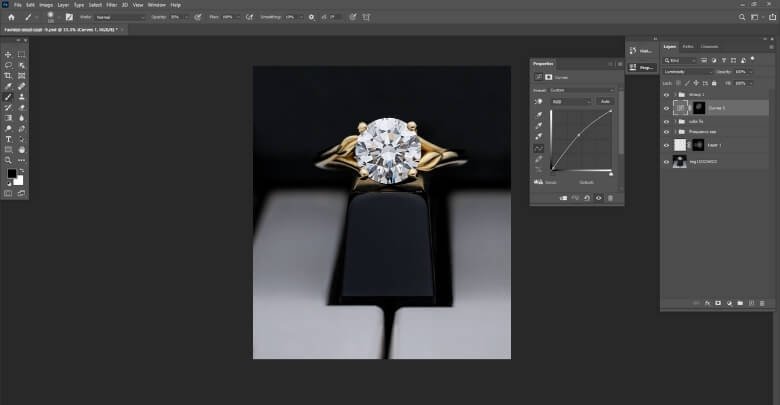
Overwhelming Workload
When your to-do list keeps growing, and you can’t catch up, it might be time to seek help from a professional service like Visual Sparrow. They can take on photo and video editing tasks, allowing you to focus on your priorities. It’s not a sign of weakness, but rather a smart strategy to manage your workload effectively. Delegating can lead to more efficient and high-quality outcomes.
Specialized Skills Required
There are times when a task requires expertise that you may not possess. In such cases, seeking professional help can save time and ensure the job is done right. For example, legal or financial matters often require specialized knowledge. Attempting to handle these on your own could lead to costly mistakes.
The key to obtaining professional help is knowing when to do so. You should never hesitate to reach out for assistance when you are overwhelmed with work, require specialized skills, or want to take care of your health and well-being. Keep in mind that seeking help is a sign of strength and a step towards achieving your goals more effectively.
Frequently Asked Questions about What Settings Should I Use for Jewelry Photography?
Here are some of the FAQs and their relevant answers for a clear concept of what settings should I use for jewelry photography:
Should I Use a Tripod for Jewelry Photography?
Yes, using a tripod is essential to ensure sharp, clear images, especially when using slower shutter speeds in low-light conditions.
Should I Use Natural or Artificial Light for Jewelry Photography?
Both natural and artificial light can be used, but natural light provides a softer, more diffused look, while artificial light allows for more control over the lighting setup.
How Can I Avoid Reflections in Jewelry Photography?
Use a polarizing filter on your lens to reduce reflections, or adjust the angle of your lights to minimize glare on shiny surfaces.
Should I Shoot in RAW or JPEG for Jewelry Photography?
Shooting in RAW format preserves more image data and allows for greater flexibility in post-processing, making it ideal for jewelry photography.
How Can I Enhance the Sparkle and Shine of Jewelry in Photos?
Use a light diffuser or softbox to create soft, even lighting that enhances the sparkle and shine of the jewelry without creating harsh reflections.
How Important is Post-processing in Jewelry Photography?
Post-processing is crucial for enhancing the details and colors of your jewelry photos, so investing in professional photo editing services like Visual Sparrow can greatly improve the quality of your images.
Final Thoughts
Experiencing jewelry photography is like starting on a journey of precision and creativity. Each setting on the camera plays a key role in showcasing the intricate details and sparkling beauty of the jewelry.
As we explore, what settings should I use for jewelry photography? We find that it requires careful consideration of factors like ISO, aperture, and shutter speed to achieve the desired clarity and depth of field.
By mastering these settings, photographers can capture the true essence of each piece as well as showcase its beauty and craftsmanship. It’s the key to creating images that not only entice potential customers but also celebrate jewelry design artistry.